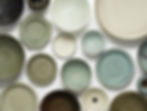拍賣筆記 vol.199 邦瀚斯倫敦:10.835萬英鎊成交,覺是軒,北宋耀州窯青釉刻鹿紋碗103.98萬人民幣售出 - Emmanuel Christofides, Priestley and Ferraro, A Large Yaozhou Celadon-Glazed Carved 'Deer And Lingzhi' Bowl
- SACA
- 6 days ago
- 3 min read
Updated: 5 days ago

103.98萬人民幣售出,1050號牌購入。十分罕見的梅花鹿,這件的題材意象吉祥,有正倉院的審美感覺。
器物侈口深腹,口沿略外撇,圈足微內斂,胎體厚重堅實,整體以青釉覆燒,色澤橄欖綠,釉色於刻紋凹陷處積釉較深,形成濃淡分明之層次美。
碗內壁雕飾一伏臥梅花鹿,身旁環繞靈芝、草葉等繁密植物紋,線條婉轉流暢,鹿首上昂,雙角分岔,回顧身後,神態自然生動,鹿身飾以壓印之梅花斑點,姿態與紋飾處理皆極具寫實精神與審美格調,展現耀州刻花工藝之成熟與高妙。
北宋 耀州窯青釉刻鹿紋碗
慧習相成:宋瓷人生
2025 年 5 月 15 日 10:00 BST
倫敦,新龐德街
£20,000 - £30,000
碗外壁下部一周飾有一圈劃線,為耀州窯典型裝飾語彙。全器構圖繁而不亂,主題集中,意涵深遠,為宋代耀州青瓷中罕見之佳作。
伏臥之鹿形主題,最早可見於粟特金屬器,其後於唐代金銀器中稍有流行,然至宋金時期,始廣泛見於織物、金屬器與瓷器等工藝品中。參見J. C. Y. Watt編著,《When Silk Was Gold: Central Asian and Chinese Textiles》,紐約,1997年,圖版29。鹿在中國文化中寓意多元,不僅象徵長壽與道教仙境,亦因「鹿」(lù)與「祿」(lù)同音,故有祿位、富貴之象徵。

相關器例比較:
可參考1983年陝西澄城縣城郊鄉出土、現藏於耀州窯博物館之金代刻花鹿紋碗,著錄於卓振希,《中國古代瓷窯址叢書·中國耀州窯》,北京,2014年,編號160。又如北京故宮博物院藏一件金代刻有望月獸形之碗,編號159。另可參見蘇富比紐約2019年3月20日拍賣,編號623,所售一件金代耀州窯刻浪花大碗。
來源:
倫敦古董商Priestley & Ferraro Chinese ArtEmmanuel Christofides (1928-2020),雅典和倫敦,於2004年11月5日從上處獲得

展覽著錄:
Priestley & Ferraro,《Recent Acquisitions》,倫敦,2004年,編號10D.Priestley和M.Flacks,《A Life in the Company of Song Ceramics》,倫敦,2017年,第118-119頁,編號53(著錄插圖)
S.Wong和S.Pierson編,《百年清賞:東方陶瓷學會的收藏家、鑑賞家及博物館員》,倫敦,2021年,第196-197頁,編號65
A LARGE YAOZHOU CELADON-GLAZED CARVED 'DEER AND LINGZHI' BOWL
Northern Song Dynasty
Thickly potted, the deep conical sides rising from a short slightly tapering foot to a lipped rim, the exterior with a grooved band beneath, the interior carved with a recumbent spotted deer amidst a dense profusion of foliage, covered in an olive-green glaze pooling to a darker tone in the recesses of the carving, box. 21.2cm (8 3/8in) diam. (2).
Provenance:
Priestley & Ferraro Chinese Art, London
Emmanuel Christofides (1928-2020), Athens and London, acquired from the above on 5 November 2004
Published, Illustrated and Exhibited:
Priestley & Ferraro, Recent Acquisitions, London, 2004, no.10
D.Priestley and M.Flacks, A Life in the Company of Song Ceramics, London, 2017, pp.118-119, no.53 (published and illustrated)
S.Wong and S.Pierson, eds., Collectors, Curators, Connoisseurs: A Century of the Oriental Ceramic Society 1921-2021, London, 2021, pp.196-197, no.65
The motif of a recumbent deer or antelope can be traced to Sogdian metalwork. In China, it first appeared briefly in Tang dynasty metalwork before re-emerging during the Song and Jin dynasties, adorning textiles brocaded with gold, metalwork, and ceramics; see J.C.Y.Watt, When Silk was Gold: Central Asian and Chinese Textiles, New York, 1997, no.29. Over time, the deer became closely associated with longevity and Daoist traditions, often depicted alongside Immortals such as Shoulao or in enchanted landscapes. Furthermore, the Chinese word for deer (lu 鹿) is a homophone for the word for wealth or official emolument (lu, 禄). This dual meaning makes the deer a symbol of prosperity and success in one's career. On this celadon-glazed bowl, the deer is rendered with remarkable naturalism, featuring a gracefully elongated head with prominent antlers, turned backward toward a rounded body detailed with impressed spotted markings. The fluidly incised lines of the deer harmonise beautifully with the deeply carved foliate background, showcasing the craftman's skilfull execution.
Compare with a similar carved celadon-glazed bowl, Jin dynasty, excavated in 1983 in Chengjiao township, Chengcheng county, Shaanxi Province and now in the Yaozhou Ceramics Kiln Museum, illustrated by Zhuo Zhenxi, Series of China's Ancient Porcelain Kiln Sites: Yaozhou Kiln of China, Beijing, 2014, no.160; and no.159, showing a horned animal gazing at the moon, Jin dynasty, in the Palace Museum, Beijing.
See a related large Yaozhou carved bowl with waves, Jin dynasty, which was sold at Sotheby's New York, 20 March 2019, lot 623.





































